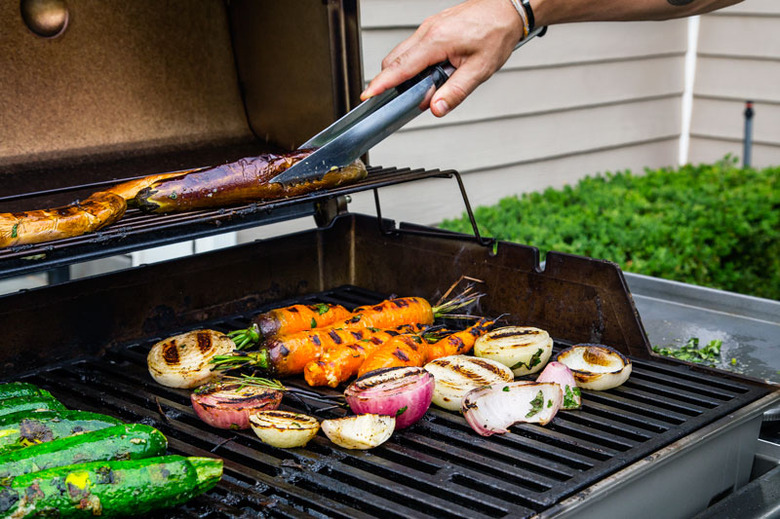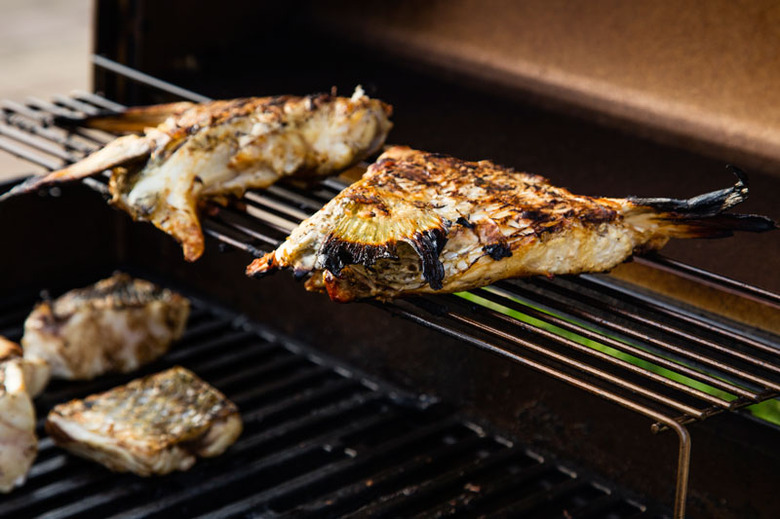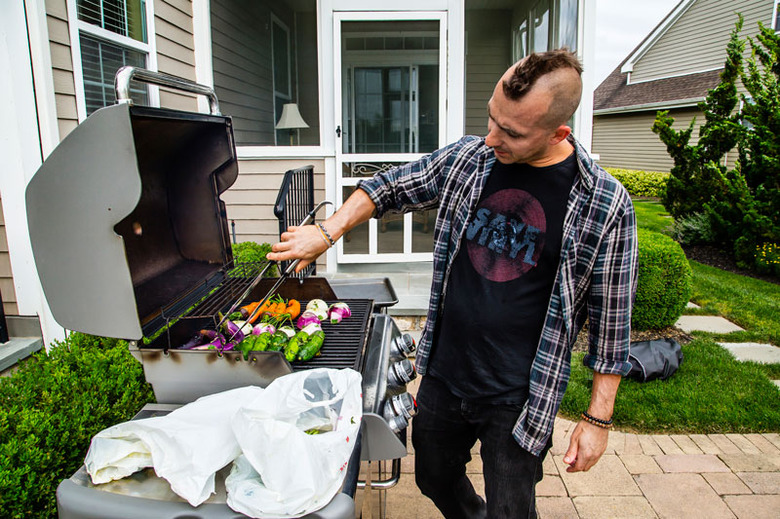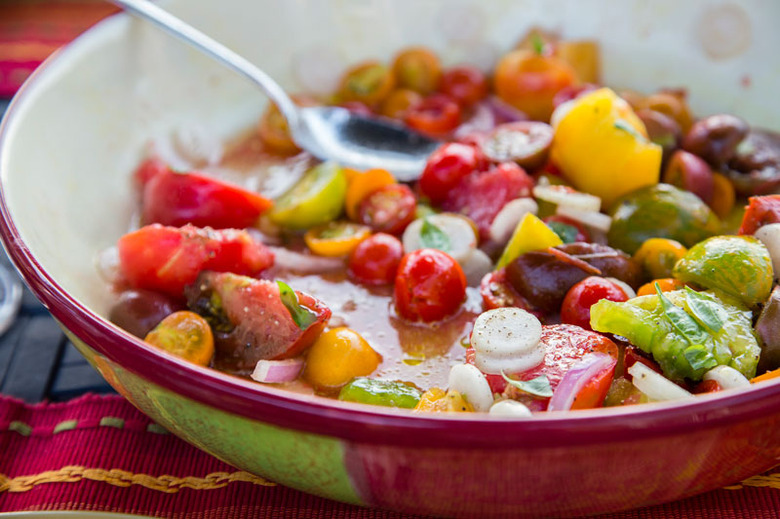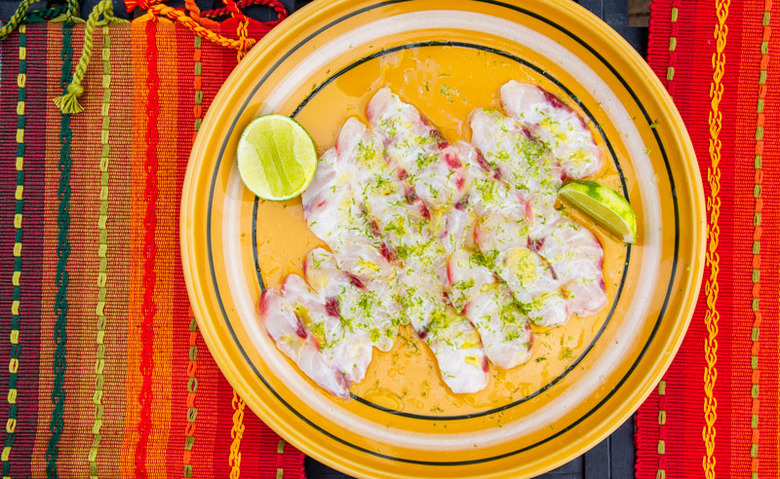Grilling And Appetizer Ideas From Marc Forgione And Chris Jaeckle
Laid-back Labor Day cooking tips from two NYC chefs
Marc Forgione and Chris Jaeckle are Long Island boys through and through.
They played peewee soccer together, survived the long treks from the island to work their way up in shiny Manhattan kitchens and, on this breezy summer day, are back on their North Fork home turf.
And they're making dinner.
 Forgione laying out the spread | Tomato salad with tomato dressing | Jaeckle's crudo
Forgione laying out the spread | Tomato salad with tomato dressing | Jaeckle's crudo
"Marc, we're bringing back the mesclun salad tonight, I think," Jaeckle yells to his Iron Chef buddy as he's breaking down a 40-pound striped bass in the kitchen of his family home off in perfectly manicured Aquebogue. (More on that monster of a fish later, but let's just say for now that Jaeckle knows the right guy.)
Jaeckle's referencing Larry Forgione, the pioneering chef behind An American Place in New York City, who coined the phrase free range, who made leafy foraged weeds into a now-ubiquitous salad—and who also happens to be Marc's father. Long before Jaeckle won over critics at his Japanese Italian restaurant All'onda and Forgione conquered the Downtown dining world with his namesake restaurant and American Cut—as well as the tube on Iron Chef America—they were just young cooks from Long Island who trained (albeit at different times) under the legendary senior Forgione.
① Get the Whole Picture
Forgione's method for grilling vegetables requires a little more time but minimal prep. Instead of chopping carrots, zucchini and eggplant into strips and worrying about them slipping through the grates, he leaves them whole on the grill. This allows for more charring and caramelizing on the outside and a softer, collapsing inside (aka way better texture overall).
Go for Alt Cuts
②
Think outside the burger patty. Jaeckle looks for alternative proteins like pork porterhouse and whole ducks. "I love slow-roasting whole ducks," he says excitedly. "Light one side of the grill and keep the flame low, put the duck on the opposite side and let it gently cook so the fat renders out." Today, he and Forgione go for fish collar, since they have it handy. "Collar usually has more fat content, so it reacts well to the high-heat cooking of a grill," he explains.
Reuse Your Plastic Baggie
③
"When you're at home, it's key," Forgione says as he throws tomatoes, onions and garlic into an unscented plastic bag. Simply throw all your vegetables for salad or marinating into a plastic shopping bag, pour in your herbs and liquids—here, he relies on garlic, parsley and a little olive oil—give it a shake and you're done. Bonus: It's one less bowl to wash later.
Tomato Juice = Natural Salad Dressing
④
We've tried this trick since our trip (for science, of course), and it's a salad game changer. Forgione squeezes fat heirloom tomatoes like lemons for salad dressing, infusing the liquid with its sweet water and fleshy hunks of tomato. For vinaigrettes, you can cut down on red wine vinegar, sherry vinegar or whatever acid you're using and sub in more of this natural, more rounded acid.
Know Your ABCs (Always Be Crudo-ing)
⑤
Skip the usual chips and dip for a more refreshing appetizer. While the grill is blazing, cool things down with crudo. Jaeckle recommends getting a whole fish to ensure freshness; look for clear eyes, bright red gills, flesh that bounces back when pressed and "the scent of the ocean." Then squeeze a bit of lime and dress it in a bit of olive oil for this easy crudo (see the recipe).
Now there is a giant fish, a bounty of local produce and a grill the two need to tend to.
"Summer is my favorite time to cook, and what I love most about the grill is you can literally cook anything on it," Jaeckle says. "Potatoes—set off to the side to let them gently cook—whole birds, large roasts, you name it. With a little adjustment of the fire, anything can be done."
Today that means busting out a trusty plastic bag to toss together salads, literally squeezing the most out of tomatoes and throwing together the easiest, freshest pre-feasting appetizer (get all the chefs' tips here).
"The less you do with it, the better when you get stuff like this . . ." Forgione says almost wistfully as he grates garlic into the bag.
Walking to the greenhouse | Koppert Cress manager Nicolas Mazard
Just hours earlier, he arrived with his fiancée, Kristen Angelilli, to meet Jaeckle and his fiancée, Lindsey Yao, for some casual microgreens picking at Koppert Cress in Cutchogue. Amid 30,000 square feet of purple shiso and flavor-morphing Tahoon cress, manager Nicolas Mazard greets the couples.
"You have a fancy kitchen. I have a fancy greenhouse," he jokes to Forgione.
Nearly 13 years ago, Mazard went from marketing the microgreens to growing them himself, which is how he initially met Forgione.
Dwarf Jewels | Forgione picking Sichuan buttons | Boxes of pea shoots
"Remember when you showed up at my restaurant with a bunch of microgreens six years ago?" Forgione recalls in between nibbles of borage.
"You asked me, 'How do I pay you?' And I said, 'Forget about it man; none of us has money,'" Mazard says with a laugh.
Mazard's like a kid in a candy factory here, passing around sprigs and asking what they taste like—ginger-like coriander leaves, anise-y purple shiso leaves, which Jaeckle has a whole case of at his restaurant.
Then he takes everyone to his newer 50-acre Riverhead farm filled with experimental microgreens and sets everyone loose. The guys stock up for their restaurants: Forgione beelines for a secret plant he asked Mazard to grow, which tastes like "it's letting you keep the ocean," while Jaeckle plucks crunchy oblong vegetables that look like tiny watermelons.
Farmer Ken Jurow with the peppers | Outside at Long Season Farms | Striped bass | The chefs' reactions
The next stop for dinner ingredients is at Jaeckle's farmer: Long Season Farms is the opposite of Koppert Cress, where Mazard donned a puffy blue hairnet and encouraged thorough hand sanitizing. Here, at the outdoor farm stand, Ken Jurow has dirt under his fingernails and a big smile.
He takes Jaeckle to the back of the stand, where he's laid out a bushel of Espelette peppers he's sun-dried himself and has that striped bass buried in an ice cooler.
RELATED All About That Bass "
"My nephew speared this," Jurow says proudly. "No lactic acid."
Garlic hangs like shrunken heads and robin's-egg blue cartons neatly line the tables filled with bulging cherry tomatoes. Forgione touches and smells everything. Then he finally gets a glimpse of the fish, and the two chefs are giddy like they've won the soccer tourney—but with more back-of-house expletives than their kiddie league days.
Forgione cutting the vegetables after grilling | Fish head and tail hanging out in the sink | Breaking down the fish | A full grill
Into the truck the fish goes, and after a double back to the farm for the basket of Espelettes, it's back to Aquebogue. Everyone gets to work without really saying a word: Jaeckle cleans the fish, about a fourth of it resting on the cutting board and the rest on the counter—"Just wait 'til my mom sees this," he laughs. And while Forgione is marinating the vegetables and grilling them whole, Jaeckle whips up a snack to hold everyone over: a refreshing crudo from the striped bass, cut a bit thicker and spritzed with lime and olive oil (see the recipe).
The tiki torches are lit, and the table is set outside, and yet, as they are wont to do, the chefs are still improvising the menu inside.
"Throw collar on the grill?" Jaeckle asks.
"Hell yeah, man," Forgione responds.

